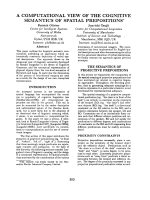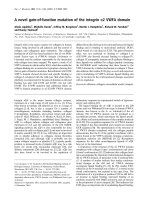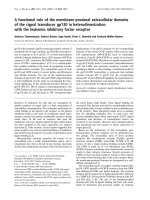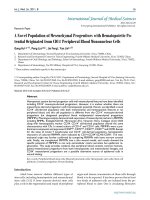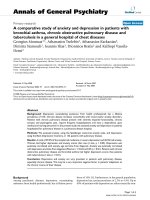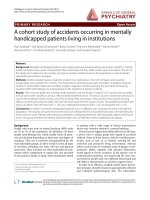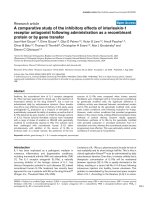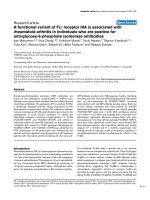Báo cáo y học: "A genomic view of methane oxidation by aerobic bacteria and anaerobic archaea" doc
Bạn đang xem bản rút gọn của tài liệu. Xem và tải ngay bản đầy đủ của tài liệu tại đây (97.47 KB, 6 trang )
Genome Biology 2005, 6:208
comment
reviews
reports deposited research
interactions
information
refereed research
Minireview
A genomic view of methane oxidation by aerobic bacteria and
anaerobic archaea
Ludmila Chistoserdova*, Julia A Vorholt
†
and Mary E Lidstrom
‡
Addresses: *Department of Chemical Engineering and
‡
Departments of Chemical Engineering and Microbiology, University of Washington,
Seattle, WA 98195, USA.
†
Laboratorie des Interactions Plantes-Microorganismes, 31326 Castanet-Tolosan, France.
Correspondence: Ludmila Chistoserdova. E-mail:
Abstract
Recent sequencing of the genome and proteomic analysis of a model aerobic methanotrophic
bacterium, Methylococcus capsulatus (Bath) has revealed a highly versatile metabolic potential. In
parallel, environmental genomics has provided glimpses into anaerobic methane oxidation by
certain archaea, further supporting the hypothesis of reverse methanogenesis.
Published: 1 February 2005
Genome Biology 2005, 6:208
The electronic version of this article is the complete one and can be
found online at />© 2005 BioMed Central Ltd
Methane is a powerful greenhouse gas, and its atmospheric
concentration has been steadily increasing over the past 300
years. There are two major ways in which methane is
removed from the environment: aerobic oxidation by a spe-
cialized group of bacteria and anaerobic oxidation by a
specialized group of archaea. The former is important for
keeping methane concentrations balanced in freshwater sed-
iments and soils, whereas the latter is the major process in
anoxic marine environments. The biochemistry of aerobic
methane oxidation is relatively well understood, following
intensive research efforts with a number of model organ-
isms, but the biochemistry of anaerobic methane oxidation
is not yet fundamentally understood and no anaerobic
methane-oxidizer has been isolated in pure culture so far.
Three recent studies using global approaches [1-3] have shed
new light on both aerobic and anaerobic systems. Here, we
first review background information on the two metabolic
systems involving methane and then discuss the insights
revealed through the three recent studies [1-3], as well as a
fourth [4] that is useful for interpreting the new results on
anaerobic methane oxidation [3].
Aerobic and anaerobic methanotrophs
Three types of aerobic methanotrophs are recognized. Type I
methanotrophs are ␥-proteobacteria that have stacked
membranes harboring methane monooxygenase (pMMO),
the enzyme for primary methane oxidation, and that use the
ribulose monophosphate (RuMP) cycle, which converts
formaldehyde into multicarbon compounds, for building cell
biomass [5]. Type II methanotrophs belong to the ␣-
proteobacteria, have rings of pMMO-harboring membranes
at the periphery of the cells, and use the serine cycle, an
alternative pathway for converting formaldehyde into
biomass; these bacteria also often contain a soluble (s) MMO
in addition to pMMO [5]. The third type, type X methan-
otrophs, belong to the genus Methylococcus (␥-proteobacte-
ria) and combine features characteristic of the other two
types: they have stacked membranes and the RuMP cycle,
but they also have elements of the serine cycle and sMMO
[5]. The type X methanotroph Methylococcus capsulatus has
been a favorite model for research because of its robust
growth on methane and its relative ease of use as a genetic
system [6-9]. Two almost identical gene clusters have been
identified encoding the subunits of pMMO, which are
expressed simultaneously and are functionally redundant
[7,8], and another gene cluster encodes the subunits of
sMMO [9]. Copper has been shown to play an essential role
in expression of the pMMO operons, whereas the sMMO
operon appears to be expressed only in low-copper condi-
tions [10]. The catalytic mechanisms for both pMMO and
sMMO [11,12] are understood on a sophisticated level, but
until recently no whole-genome sequence has been available
for M. capsulatus or for any other methanotroph. Two recent
studies [1,2] have used a whole-genome-shotgun sequencing
approach to complement the mounting dataset on the bio-
chemistry and regulation of aerobic methane oxidation.
In contrast, understanding of the process of anaerobic
methane oxidation is in its infancy. Geochemical evidence
points strongly towards a coupling of anaerobic methane
oxidation with sulfate reduction [13]. Microbes involved in
this process have been identified recently as archaea related
to Methanosarcinales that fall phylogenetically into two dis-
tinct groups, ANME-I and ANME-II; these are normally
found in association with sulfate-reducing bacteria [13].
There is no clear concept of how methane oxidation is
linked to sulfate reduction; Figure 1 shows a possible model.
This co-metabolism has to be viewed in the light of the ther-
modynamic constraints, however; the free energy (⌬G) for
anaerobic methane oxidation in situ is estimated at -20 to
-40 kJ/mol), the lowest value described that enables micro-
bial growth [13,14].
There is agreement on the hypothesis that reverse methano-
genesis plays a key role in the methane oxidation process
[13,14]: most enzymes of methanogenesis are easily
reversible, and part of the methanogenesis pathway oper-
ates in reverse for energy generation in Methanosarcina
species growing on such substrates as methanol or methyl-
amine [15,16]. But the last step of methanogenesis and pre-
sumably the first in anaerobic methane oxidation (step 1 in
Figure 1), catalyzed by methyl-coenzyme M reductase
(MCR), presents a mechanistic challenge given the fact that
methane is chemically unreactive. Nevertheless, data have
been obtained showing that methanotrophic archaea have
homologs of the genes for all three subunits of MCR, sug-
gesting that MCR or a similar enzyme may indeed be
208.2 Genome Biology 2005, Volume 6, Issue 2, Article 208 Chistoserdova et al. />Genome Biology 2005, 6:208
Figure 1
A proposed pathway for anaerobic oxidation of methane involving the homolog of methyl-CoM reductase and a novel methylene-tetrahydromethanopterin
(H
4
MPT) reductase (Mer), and its connection with the sulfate reduction pathway. (a) The reverse methanogenesis pathway. Solid arrows represent
enzymes predicted from the sequences found by Hallam et al. [3]; the dotted arrow represents the one enzyme that was not predicted, methylene
H
4
MPT-reductase (Mer). Enzymes performing steps 1-7: 1, Methyl-CoM reductase-like protein (MCR); 2, Methyl-H
4
MPT:coenzyme M (CoM) methyl-
transferase (Mtr); 3, Methylene-H
4
MPT reductase (Mer); 4, F
420
-dependent methylene-H
4
MPT dehydrogenase (Mtd); 5, Methenyl-H
4
MPT cyclohydrolase
(Mch); 6, Formyl-MFR:H
4
MPT formyltransferase (Ftr); 7, Formyl-MFR dehydrogenase (Fmd). (b) Reverse methanogenesis is thought to be connected to
sulfate reduction through an unknown intermediate (X); e
-
represents an electron. Hallam et al. [3] suggest that steps 1 and 2 in (a) function in the down
direction and methyl-H
4
MPT is used for biomass generation (c), while steps 4 to 7 function in the up direction and the methylene-H
4
MPT produced is either
converted to biomass through the serine cycle or is oxidized to CO
2
. We suggest that Mer or an analogous enzyme probably performs step 3 instead.
2 e
−
2 e
−
2 e
−
2 e
−
6 e
−
2 e
−
Acetyl-CoA
Biomass
CH
4
Methyl-H
4
MPT
Methenyl-H
4
MPT
Formyl-H
4
MPT
Formyl-MFR
Methylene-H
4
MPT
Methyl-S-CoM
CO
2
SO
4
−
SO
3
−
HS
−
X
7
6
5
4
3
2
1
(a) Reverse methanogenesis
(c) Biomass generation
(b)
Sulfate reduction
responsible for anaerobic methane oxidation [17]. Two
recent studies [3,4] describe efforts to establish the roles of
mcr homologs and of other genes potentially involved in
reverse methanogenesis by directly assessing environmen-
tal DNA and protein pools.
Genomic insights into the aerobic
methanotrophy of M. capsulatus
In a paper recently published in PLoS Biology, Ward et al.
[1] describe the complete genomic sequence of Methylococ-
cus capsulatus (Bath). They annotate the genome in terms of
the specific adaptations this organism has evolved in order
to succeed at a lifestyle solely dependent on utilization of
methane. The genome of M. capsulatus (3.3 megabases, Mb)
is much smaller than the genome of a model facultative
methylotroph, Methylobacterium extorquens AM1 (7 Mb), a
bacterium with a much more versatile lifestyle [18], but is
comparable in size to the genome of another obligate
methylotroph, Methylobacillus flagellatus (2.9 Mb) [19],
suggesting that the degree of specialization in methylotro-
phy may correlate with genome size. The cause of the oblig-
ate methylotrophy of M. capsulatus remains unresolved,
however. The tricarboxylic acid (TCA) cycle is the pathway
that converts acetyl-CoA to CO
2
and is the major source of
reducing equivalents during growth on multicarbon com-
pounds; the long-held hypothesis that M. capsulatus lacks a
complete TCA cycle [20] has not been proven true by
genome sequencing, as putative genes for all the enzymes of
the cycle were identified in the recent study [1]. In addition,
the organism seems to encode an array of enzymes that
could metabolize sugars, so the inability of M. capsulatus to
grow on sugars remains enigmatic.
Analysis of the genes encoding enzymes involved in the
metabolism of single-carbon compounds in M. capsulatus
(Figure 2) has been greatly simplified by the addition of data
available from pre-genomic analyses [7-9,21] and from the
initial analysis of the genome of M. extorquens [18]. As
expected, all the genes encoding enzymes of the RuMP
pathway have been identified. In accordance with previous
observations, most of the genes for the serine cycle were also
found, as were the genes for the Calvin-Benson-Bassham
(CBB) cycle, the pathway that reduces CO
2
and converts it
into biomass (Figure 2f) [5,20]. The potential to operate all
three known pathways for the assimilation of single-carbon
compounds that are found in various methylotrophs makes
this organism unique, but further analysis involving knock-
out mutations is needed to understand the functions of each
of the three pathways.
Proteomics of M. capsulatus
The first glimpses into the expression patterns of pathways
enabling methanotrophy are coming from a proteomic analy-
sis of M. capsulatus by a group that has independently
sequenced the M. capsulatus genome to 8X coverage [2]. In
this work [2], quantitative proteomic analysis was performed
in order to compare the response of M. capsulatus to low-
copper and high-copper conditions. Kao et al. [2] identified a
total of 682 differentially expressed proteins using a cleavable
isotope-coded affinity tag (cICAT) technique. The authors [2]
demonstrated that, as expected, pMMO is overexpressed in
conditions of high copper whereas sMMO is expressed at low
copper levels. Equally interesting data from this work
concern the expression of proteins other than MMOs, indi-
cating that, indeed, all three assimilatory pathways are simul-
taneously expressed. The oxidative pathway linked to
tetrahydromethanopterin (H
4
MPT) is one of the pathways by
which formaldehyde can be oxidized to CO
2
(Figure 2b); all
the enzymes in this pathway were identified [2], pointing to
the importance of this pathway, as suggested previously by
enzyme-activity measurements [22]. Peptides for the oxida-
tive branch of the RuMP cycle were also identified [2], sug-
gesting that it is operational in M. capsulatus (Figure 2a).
Some of the major serine-cycle enzymes were found to be
overexpressed under high-copper conditions [2]. It is
unlikely, however, that their expression would be directly
regulated by copper; it is more likely that they are respond-
ing to the higher flux of formaldehyde that occurs during
growth under high-copper conditions. It is important to note
that the serine cycle cannot operate as a major assimilatory
pathway in M. capsulatus unless the two-carbon compound
glyoxylate that is depleted during the cycle can be regener-
ated [20], but no genes have been identified in the genome
that potentially encode either of the enzyme systems that can
convert acetyl-CoA into glyoxylate: the isocitrate lyase and
the glyoxylate-regeneration cycle [23].
Given these considerations, what might the function of the
serine cycle (and the interconnected TCA cycle) be in
M. capsulatus? We suggest that a possible role for this
pathway could be to handle the extra flux of formaldehyde
that the organism may encounter under certain growth con-
ditions (Figure 2c). The excess of formate generated in the
H
4
MPT-linked pathway (Figure 2b) could also be redirected
into the serine cycle after reduction to methylene-tetrahy-
drofolate (methylene-H
4
F; Figure 2d). Acetyl-CoA and other
intermediates generated in this way could serve as building
blocks for cell biomass.
The role of the CBB cycle in M. capsulatus (Figure 2f) is not
clear at present. Given that the fixation of CO
2
is a far less
efficient mechanism of carbon sequestration than the
RuMP or serine cycles, a significant amount of carbon
shunted through the CBB cycle would be predicted to
decrease growth yield. It is possible, however, that it serves
to reduce the local concentration of CO
2
and/or to generate
intermediates for biomass production. Once again, further
experiments are needed to establish the validity of these
hypotheses.
comment
reviews
reports deposited research
interactions
information
refereed research
Genome Biology 2005, Volume 6, Issue 2, Article 208 Chistoserdova et al. 208.3
Genome Biology 2005, 6:208
A novel MCR-like enzyme and anaerobic
methane oxidation
To provide support for the hypothesis that reverse methano-
genesis is important in anaerobic methanotrophy, a consor-
tium of researchers focused on identifying the enzyme
potentially involved in the initial step of anaerobic methane
oxidation; this enzyme is hypothesized to be similar to the
bacterial MCR (Figure 1, step 1). A microbial mat in the
Black Sea largely consisting of ANME-1-type archaea was
chosen as a source of this hypothetical enzyme. As described
in Nature in 2003 by Krüger et al. [4], a conspicuous protein
consisting of three subunits similar to the ␣, , and ␥ sub-
units of MCR is abundantly present in this microbial mat
(7% of the total extracted protein), suggesting that it has an
important role in anaerobic methane oxidation. The protein
contains a variant of F
430
, a cofactor used by the classical
MCR, but the two cofactors differ in molecular weight as
determined by mass spectrometry. The genes encoding this
protein were sequenced as a part of an insert detected in an
environmental DNA library [4]. Alignment of amino-acid
sequences translated from these genes with the respective
sequences of methanogen MCR subunits showed that
residues involved in active-site formation in the  and ␥ sub-
units were conserved, but one of the important residues in
the active site of the ␣ subunit was substituted. It is interest-
ing to speculate that this modification of the active site and
208.4 Genome Biology 2005, Volume 6, Issue 2, Article 208 Chistoserdova et al. />Genome Biology 2005, 6:208
Figure 2
Pathways in the aerobic methanotrophic bacterium Methylococcus capsulatus involved in the metabolism of single-carbon compounds, as determined by
genome sequencing and proteome analysis. Formaldehyde produced from methane can be metabolized in the following alternative ways: (a) through the
ribulose monophosphate (RuMP) cycle, which can either generate biomass (via the assimilatory (A) RuMP cycle) or CO
2
(via the dissimilatory (D) RuMP
cycle); (b) by conversion to formate via intermediates containing tetrahydromethanopterin (H
4
MPT); (c) via methylene-tetrahydrofolate (methylene-
H
4
F) to the serine cycle and from there into biomass. Under certain conditions, there can be an excess of formaldehyde and formate; the former can be
used up through pathway (c) and the latter by reduction to methylene-H
4
F (d) and thus directed into the serine cycle. CO
2
produced in any of these
reactions can be converted to biomass by either (e) the serine cycle or (f) the Calvin-Benson-Bassham (CBB) cycle.
Methylene-H
4
F
Methenyl-H
4
F
Formyl-H
4
F
Biomass
Biomass
Biomass
Serine
cycle
TCA
cycle
CBB
cycle
RuMP
cycle (A)
RuMP
cycle (D)
O
2
+ 2 e
−
2 e
−
2 e
−
2 e
−
CH
4
(Methane)
Methenyl-H
4
MPT
Formyl-H
4
MPT
Formate
Methylene-H
4
MPT
CO
2
CH
3
OH (Methanol)
CH
2
O (Formaldehyde)
(a) (b) (c)
(d)
(e)
(f)
the use of a modified F
430
cofactor could provide a mecha-
nism for the biochemical activation of methane and could
make the first step of reverse methanogenesis thermody-
namically and kinetically possible. Further in-depth mecha-
nistic studies of this enzyme will be of great interest.
The environmental genomics of reverse
methanogenesis
In a recent paper published in Science, Hallam et al. [3]
describe a large environmental sequencing effort which
aimed to provide further evidence for the hypothesis of
reverse methanogenesis. The group [3] isolated DNA from a
520-meter-deep sediment of Eel River Basin in California,
known for a high abundance of ANME-1 and ANME-II
archaea, and used it for both whole-genome shotgun analy-
sis and fosmid ‘walking’ (fosmids are large-insert plasmids).
A total of 111.3 Mb of non-redundant sequence was gener-
ated by shotgun sequencing and another 4.6 Mb more were
generated by fosmid-end sequencing. Fosmids containing
either 16S rRNA genes belonging to ANME-I or ANME-II
archaea or homologs of the mcrA gene were analyzed in
detail, producing an additional 7.4 Mb of sequence.
The main conclusion from this work [3] is that ANME archaea
contain most of the genes involved in methanogenesis, with
one exception: mer, the gene encoding methylene-H
4
MPT
reductase (step 3 of reverse methanogenesis; see Figure 1)
[15]. On the basis of the apparent lack of mer, the authors
propose a model in which parts of the methanogenesis
pathway function in two opposite directions: a novel MCR-like
enzyme oxidizes methane to methyl-CoM (step 1), and methyl-
H
4
MPT:CoM methyl-transferase catalyzes a reverse reaction
to produce methyl-H
4
MPT (step 2), while the rest of the
enzymes reduce CO
2
to methylene-H
4
MPT (steps 4 to 7 in
reverse); that is, contrary to previous models [13,14], methane
is not oxidized to CO
2
by ANME archaea. This proposed sce-
nario creates some metabolic difficulties, however. Firstly, the
model aggravates the thermodynamic constraints mentioned
earlier, given that reduction of CO
2
to formyl-methanofuran
(step 7) is an energy-consuming reaction (⌬G
0
= +16 kJ/mol)
[15]. Secondly, the fate of the methylene-H
4
MPT produced in
steps 4 to 7 is proposed to involve either the assimilatory
serine cycle or formaldehyde oxidation, but the high energy
cost of such schemes would suggest they could operate only as
minor pathways, not as major assimilatory or detoxification
pathways. Thirdly, there is no discussion by Hallam et al. [3]
of how net CO
2
would be produced from methane.
Thus, although the schemes presented by Hallam et al. [3]
are an attempt to explain how methane metabolism might
function in the absence of mer, they highlight the many
aspects of this metabolic mode that are still unknown. Two
different explanations might be that either mer has simply
not been detected because of incomplete sequence data, or
that the function of Mer is fulfilled by a novel enzyme (a
non-homologous substitution), possibly involving a cofactor
different from F
420
, so the reverse-methanogenesis pathway
might in fact be complete (as in Figure 1). An example of
such a non-homologous substitution is seen in methy-
lotrophic bacteria, in which a version of the ‘reverse
methanogenesis’ pathway has been found to operate where
an NAD(P)-linked methylene-H
4
MPT dehydrogenase acts in
place of unrelated F
420
-linked or H
2
-forming enzymes [24].
In conclusion, recent studies involving both organismal and
environmental genomics shed new light on the biochemical
details of the two processes important for methane balance
on Earth - aerobic and anaerobic methane oxidation - and
suggest that these processes have more in common than just
the substrate, methane, and the final oxidation product,
CO
2
. Both processes involve common cofactors, such as
H
4
MPT, common single-carbon intermediates bound to
H
4
MPT, and common or similar enzymes for core reactions.
Although some enzymes involved in reactions that shift
single-carbon compounds between different levels of oxida-
tion are evolutionarily related in both processes, the primary
methane oxidation enzymes, MMO and the newly identified
MCR homolog, must have evolved independently and are
fundamentally different.
Acknowledgements
L.C. and M.E.L. acknowledge support from the NSF Microbial Observato-
ries program. J.A.V. acknowledges support from the CNRS and the MPG.
References
1. Ward N, Larsen O, Sakwa J, Bruseth L, Khouri H, Durkin AS, Dim-
itrov G, Jiang L, Scanlan D, Kang KH, et al.: Genomic insights into
methanotrophy: the complete genome sequence of Methy-
lococcus capsulatus (Bath). PLoS Biol 2004, 2:e303.
2. Kao WC, Chen YR, Yi EC, Lee H, Tian Q, Wu KM, Tsai SF, Yu SS,
Chen YJ, Aebersold R, Chan SI: Quantitative proteomic analysis
of metabolic regulation by copper ions in Methylococcus
capsulatus (Bath). J Biol Chem 2004, 279:51554-51560.
3. Hallam SJ, Putnam N, Preston CM, Detter JC, Rokhsar D, Richard-
son PM, DeLong EF: Reverse methanogenesis: testing the
hypothesis with environmental genomics. Science 2004,
305:1457-1462.
4. Krüger M, Meyerdierks A, Glöckner FO, Amann R, Widdel F, Kube
M, Reinhardt R, Kahnt J, Böcher R, Thauer RK, Shima S: A conspic-
uous nickel protein in microbial mats that oxidize methane
anaerobically. Nature 2003, 426:878-881.
5. Lidstrom ME: Aerobic methylotrophic prokaryotes. In The
Prokaryotes, 3rd edition, Edited by Stackebrandt E. New York:
Springer-Verlag; 2001.
6. Yu SS, Chen KH, Tseng MY, Wang YS, Tseng CF, Chen YJ, Huang
DS, Chan SI: Production of high-quality particulate methane
monooxygenase in high yields from Methylococcus capsula-
tus (Bath) with a hollow-fiber membrane bioreactor. J Bacte-
riol 2003, 185:5915-5924.
7. Stolyar S, Costello AM, Peeples TL, Lidstrom ME: Role of multiple
gene copies in particulate methane monooxygenase activity
in the methane-oxidizing bacterium Methylococcus capsula-
tus Bath. Microbiol 1999,145:1235-1244.
8. Stolyar S, Franke M, Lidstrom ME: Expression of individual copies
of Methylococcus capsulatus (Bath) particulate methane
monooxygenase genes. J Bacteriol 2001, 183:1810-1812.
9. Csaki R, Bodrossy L, Klem J, Murrell JC, Kovacs KL: Genes
involved in the copper-dependent regulation of soluble
comment
reviews
reports deposited research
interactions
information
refereed research
Genome Biology 2005, Volume 6, Issue 2, Article 208 Chistoserdova et al. 208.5
Genome Biology 2005, 6:208
methane monooxygenase of Methylococcus capsulatus
(Bath): cloning, sequencing and mutational analysis. Microbiol
2003, 149:1785-1795.
10. Murrell JC, Gilbert B, McDonald IR: Molecular biology and regu-
lation of methane monooxygenase. Arch Microbiol 2000,
173:325-332.
11. Lipscomb JD: Biochemistry of the soluble methane monooxy-
genase. Annu Rev Microbiol 1994, 48:371-399.
12. Chan SI, Chen KH, Yu SS, Chen CL, Kuo SS: Toward delineating
the structure and function of the particulate methane
monooxygenase from methanotrophic bacteria. Biochem
2004, 43:4421-4430.
13. Valentine DL: Biogeochemistry and microbial ecology of
methane oxidation in anoxic environments: a review. Antonie
Van Leeuwenhoek 2002, 81:271-282.
14. Strous M, Jetten MSM: Anaerobic oxidation of methane and
ammonium. Annu Rev Microbiol 2004, 58:99-117.
15. Thauer RK: Biochemistry of methanogenesis: a tribute to
Majory Stephenson. Microbiol 1998, 144:2377-2406.
16. Deppenmeier U: The membrane-bound electron transport
system of Methanosarcina species. J Bioenerg Biomembr 2004,
36:55-64.
17. Hallam SJ, Girguis PR, Preston CM, Richardson PM, DeLong EF:
Identification of methyl coenzyme M reductase A (mcrA)
genes associated with methane-oxidizing archaea. Appl
Environ Microbiol 2003, 69:5483-5491.
18. Chistoserdova L, Chen SW, Lapidus A, Lidstrom ME: Methylotro-
phy in Methylobacterium extorquens AM1 from a genomic
point of view. J Bacteriol 2003, 185:2980-2987.
19. Methylobacillus flagellatus draft genome [-
psf.org/draft_microbes/metfl/metfl.home.html]
20. Anthony C: Biochemistry of methylotrophs. Academic Press, London;
1982.
21. Baxter NJ, Hirt RP, Bodrossy L, Kovacs KL, Embley TM, Prosser JI,
Murrell JC: The ribulose-1,5-bisphosphate carboxylase/oxyge-
nase gene cluster of Methylococcus capsulatus (Bath). Arch
Microbiol 2002, 177:279-289.
22. Vorholt JA, Chistoserdova L, Stolyar SM, Thauer RK, Lidstrom ME:
Distribution of tetrahydromethanopterin-dependent enzymes
in methylotrophic bacteria and phylogeny of methenyl
tetrahydromethanopterin cyclohydrolases. J Bacteriol 1999,
181:5750-5757.
23. Korotkova N, Chistoserdova L, Kuksa V, Lidstrom ME: Glyoxylate
regeneration pathway in the methylotroph Methylobac-
terium extorquens AM1. J Bacteriol 2002, 184:1750-1758.
24. Hagemeier CH, Chistoserdova L, Lidstrom ME, Thauer RK, Vorholt
JA: Characterization of a second methylene tetrahy-
dromethanopterin dehydrogenase from Methylobacterium
extorquens AM1. Eur J Biochem 2000, 267:3762-3769.
208.6 Genome Biology 2005, Volume 6, Issue 2, Article 208 Chistoserdova et al. />Genome Biology 2005, 6:208
